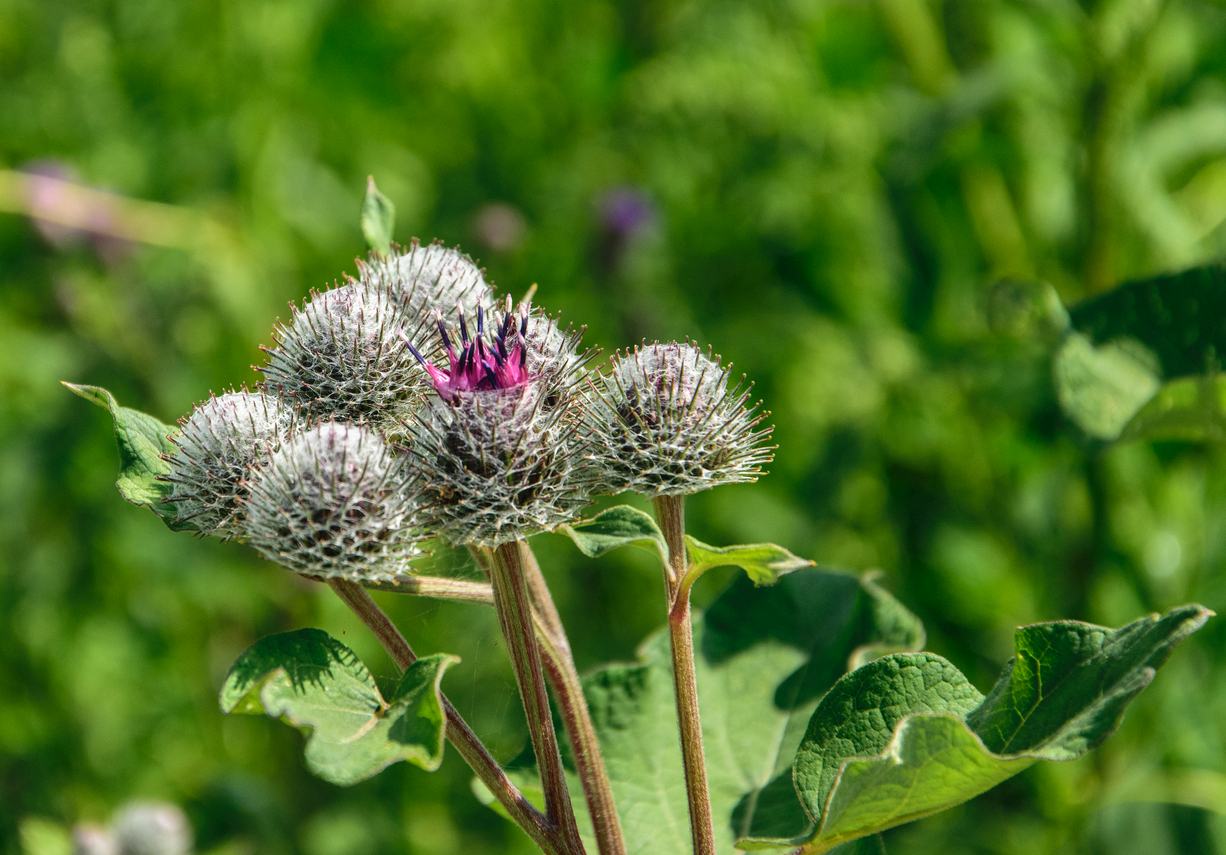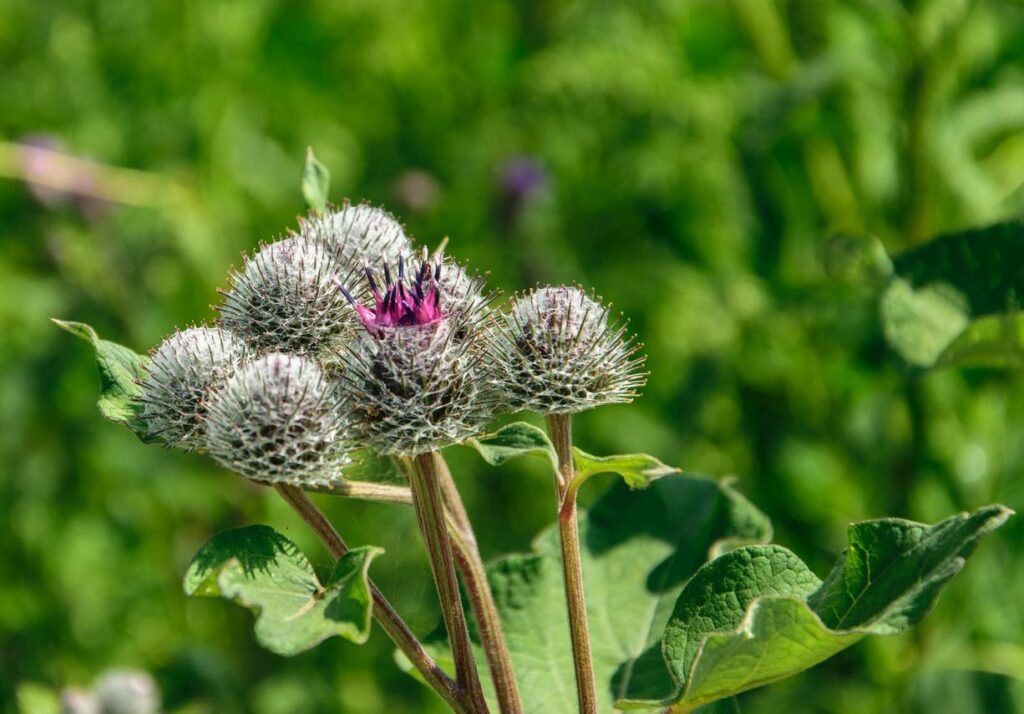Burdock Plant Care – How To Grow And Harvest Burdock
One of the funniest things about the burdock plant is that it’s the reason we have Velcro. The way the burrs cling to clothes and surfaces gave inventor George de Mestral the idea for Velcro. But you won’t be growing burdock in your garden for its burrs. Usually, it’s the roots, tender stems, and offshoots that give this herb its place in history as well as gardens across the country. These are the edible parts and they go into everything from traditional medicine to cuisines all over the globe.
Since it already grows in the wild, you can imagine how easy it is to plant and propagate this versatile herb. Caring for the plant is also straightforward. Here’s everything you need to know about growing and harvesting the burdock plant.
Burdock Plant at a Glance
Burdock (Arctium lappa) is a herbaceous perennial native to Europe and Asia. The first settlers brought it with them to America and introduced it to Native Americans who took full advantage of its medicinal benefits. It goes by many other names including eddick, hurr-burrs, harlock, edible goberon, and beggar’s buttons.
But just because it’s a herb doesn’t mean it cannot grow tall and wide. The mature plant can reach 9 feet tall and spread out to claim every inch of space. You can use the fresh leaves and offshoots in cooking the same way you’d use spinach or other green leafy veggies. But it’s usually the roots that would be of interest for you and the main reason you’d want to grow burdock in your garden.
You can eat the young root after washing and peeling it. It tastes very much like parsnip or artichoke depending on the variety and growing conditions. As for the mature root, it will need to be peeled and cooked before you can eat it. The flavor is often sweet but a little pungent and the crunchy roots are packed with juices. However, some varieties are very bitter and can only be eaten cooked.
The flowers are usually purple with white spikes that form a ball. Once they pollinate they fade and are replaced by burrs. In most cases, you wouldn’t want that to happen. The burrs are notoriously clingy and hard to detach from pets, clothes, and other surfaces they latch themselves to.
Benefits of Burdock Plant
The benefits of burdock extend beyond peeling and eating raw or cooked. In many cultures, it has been used as a staple in traditional medicine, not just in Asia but also by Native Americans. Here are some of the benefits of burdock.
- The root of the burdock is packed with antioxidants. These protect against cell damage and heart disease.
- You can eat it raw or cooked to help purify the blood and get rid of free radicals.
- Recent research found a link between the herb and inhibiting certain types of cancer.
- In traditional medicine, it treats different skin conditions including eczema and acne.
- It also helps against tropical burns.
- The seeds in Chinese medicine are a reliable cure for the common cold and coughs.
That said, health experts recommend you only take it in small doses. It might have adverse effects on pregnant women or people who have diabetes. So always consult your physician before you consume this herb in large quantities.
Burdock Plant Varieties
In nature, burdock comes in many natural varieties. However, if you want to grow it in your garden, there are two cultivars that excel with their disease resistance and natural flavors.
- Great Burdock: This variety can grow to 9 feet tall in the right conditions. It has alluring purple blooms that attract pollinators. It has large green leaves with pink veins. The stalks are often upright and end with clusters of flowers at the top.
- Common Burdock: Not as tall as the Great Burdock and the flowers grow on short stalks. The stems are usually hollow. But other than that the two varieties are almost identical in root shape and flower color.
Don’t grow natural burdock varieties since they are considered invasive weeds in some states. So wild types are quite bitter, unlike the cultivars which are edible even when not cooked.
How to Grow Burdock Plant in your Garden
Before you plant burdock in your garden check the local guidelines in your state. In some states such as Wyoming and Colorado, burdock is an invasive plant. The safest way is to only grow either one of the two cultivars we mentioned above. Here’s how to plant burdock in your garden in easy steps.
- Make sure you have enough space for the herb in your garden. The mature plant needs space about 8 feet high and 6 feet wide.
- Select a sunny spot that gets partial shade in the afternoon.
- Till the soil in advance. Use a hoe to break about 2 feet of the topsoil to accommodate the roots of the plant.
- Add organic compost to the soil since this herb is a heavy feeder.
- If you have heavy soil or clay, mix in a generous portion of sand to improve drainage.
- Before planting, soak the seeds overnight. Get rid of any seeds that float since these are bad seeds that wouldn’t germinate.
- Dig a small hole about a quarter inch in the tilled soil and plant the seeds. Space them out about 3 inches apart. Cover with loose soil.
- Water the seeds enough to make the soil moist. Don’t overwater them.
- Seeds germinate within a couple of weeks depending on the temperature of the soil.
- When the seedlings are about 3 inches tall, thin them out and keep them at 6 inches apart taking out the sickly seedlings.
Burdock Plant Care
One thing about herbs that grow naturally in the wild is that they are hardy. Some varieties of burdock have USDA hardiness zones of 3. That just tells you what a tough plant this perennial herb is.
Sun and Soil
The loose the soil the better. Loamy and sandy soil is usually the best. It’s well-drained and allows the roots of the burdock to grow and penetrate it easily. Apart from that, this herb isn’t very particular about the acidity, alkalinity, or pH levels. A slightly acidic type of soil is usually the best. But it can grow and thrive in alkaline soil as well. You can have pH levels between 4.6 and 7.5 without impacting the growth of the roots. However, the flavor and taste will vary wildly based on the type of soil. As for the natural light, this perennial plant prefers morning sun and partial shade in the afternoon.
Water
The reason we insist on well-drained soil is that most garden plants, burdock included, don’t have a high tolerance for waterlogged soil. Even with roots that look sturdy and hard to pull out, this herb likes its soil moist not wet. So water it when the topsoil is dry not before. When you irrigate the plants, don’t soak the soil. It still needs a lot of water so irrigate it regularly especially during the summer months. Don’t starve it for water since that could make the roots bitter to the taste. Healthy and edible roots need a fair amount of water on a regular basis.
Fertilizer
Remember that organic compost you mixed into the soil when preparing your garden for planting burdock? You’ll need more fertilizing to get your herbs to grow and flourish. Even if you have rich soil, some well-balanced fertilizer won’t hurt. If you prefer to stay organic since this is an edible plant, then use slow-release organic fertilizer to nourish the roots for many weeks without burning them or impacting the flavors and aroma. Fertilizers are only necessary for poor soil that lacks organic materials.
Pruning
While the burdock plant likes to spread out, for the most part, you won’t have to worry about pruning it or keeping those leaves and stems in line. However, it’s the flowers that need your attention. Unless you want the seeds to prepare some traditional medicinal potion, you’d want to snip the flowers before they pollinate. The flowers usually fade and make way for burrs that carry seeds to form. Also removing the flowers conserves the plant’s energy and lets it focus on growing healthier and tastier roots.
Harvest
If you like many gardeners grow burdock for its roots, then you need to know when those roots are ripe and ready to harvest. Since they’re buried deep into the soil, that might not be easy to figure out. However, the two cultivars that you can grow in your garden become ripe between 3 to 4 months after you plant the seeds. As for the leaves, you should always gather them young since the mature ones are not as tasty or tender.
Pull the roots up from the soil using both hands. If you have back problems you might want to do this kneeling down and keeping your back straight. Some gardeners dig a trench around the roots using a spade to make it easier to pull them up.
Pest and Diseases
Slugs and snails are the two pests that inflict the most damage to your burdock roots. What makes them even harder to detect is that they are hidden from sight under fallen leaves and debris in the garden. So clean up the area around the burdock patch and check the soil around the roots for signs of these stubborn pests. It also helps to water your plants in the morning so that the soil gets dry in the evening which discourages the nocturnal slugs.
As for diseases, the two cultivars Great Burdock and Common Burdock are usually resistant to most diseases. As long as you water the plants with adequate amounts and not let the plants sit in a pool of water, you won’t have a problem with root rot.

